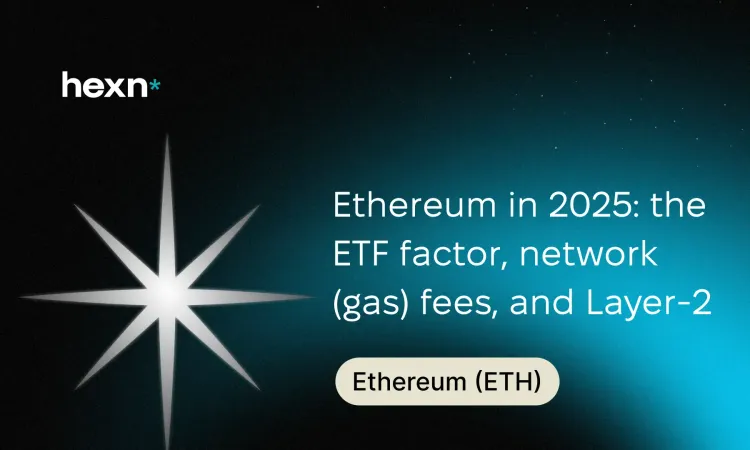Ethereum in 2025: The ETF factor, Network (Gas) Fees, and Layer-2 — How to Pay Less
The ETH price and your transaction costs depend on demand for the blockchain, news about an Ethereum ETF, and current network load. Below we explain why gas fees rise, how to reduce them with Layer-2, when it’s cheaper to transact, and how to minimize bridge and allowance risks.
Key ETH drivers
Short term. ETH price and blockspace costs are driven by market volatility, Ethereum ETF headlines, derivatives liquidations, and activity spikes (NFTs, airdrops). When demand for blocks increases, gas fees rise.
Long term. Issuance/burn balance after the Merge, maturation of L2 ecosystems, institutional demand (ETF/ETP, custodians), and regulation.
ETF factor. Net inflows/outflows into spot ETFs shift the buy/sell balance and trader behavior. On heavy-flow days, DEX/bridge fees and spreads are usually higher—plan ahead.
Gas-fees 101: what your fee consists of and why it “jumps”
Post-EIP-1559, your fee comprises: the base fee (burned; driven by block demand), the priority fee (tip to validators for priority), and your max fee (the cap that protects you during sudden spikes).
Why fees rise:
- Load peaks: mass mints/airdrops, market-moving news.
- Complex transactions: multi-hop swaps, collection mints, bridges with extra verification.
- Network queues: more pending tx → higher base fee.
Typical patterns:
- Fees are often lower overnight UTC than in “prime time.”
- Weekday daytimes tend to be pricier than weekends (a tendency, not a rule).
- Protocol releases and big announcements usually push gas higher.
What are Ethereum fees like right now?
Fees are at multi-month lows. During quiet hours, L1 transactions often cost under $1, while on L2 they’re just a few cents. Remember: complex routes (multiple aggregator “hops,” mints/bridges) can cost notably more—always check the final quote before confirming.
How to pay less: L2 by default, timing, and batching
Move day-to-day activity to Layer-2—Arbitrum, Optimism, Base, zkSync, Starknet, Linea—where transactions are typically much cheaper and confirm faster. Savings are greatest on swaps, mints, and frequent small actions.
Keep an operational balance on L2.
- Deposit/withdraw directly to L2 via CEXs that support it to avoid paying an expensive L1 bridge every time.
- Compare total route cost: one pricey L1 bridge can pay for dozens of cheap L2 actions.
Timing matters. Do non-urgent swaps/bridges outside hype windows—before/after news, not at the exact moment. If it can wait, use limit orders on DEX aggregators with delayed execution.
Batching & optimization
- Enable Batch/Multicall where a dApp supports it—combine steps into one transaction.
- Use capped approvals instead of “infinite” — you’ll save on future revokes and reduce risk.
- Where available, use Permit/Permit2—grant approval via signature without a separate approve tx.
Safety first
Bridges. Use official bridges or vetted aggregators. Understand the L2 type, exit path back to L1, and who operates it. For large amounts, test with a small transaction first.
DEXes & aggregators. Access protocols only from bookmarks, verify domains and contract addresses, and review simulations before signing.
Allowances. Grant permissions for the exact amount you need, regularly revoke stale approvals, and keep a list of dApps you’ve used—clean it up periodically.
Wallet segmentation. A cold wallet for storage, a hot wallet for daily use, and a burner for new dApps/airdrop tests.
Hardware signing. Connect a hardware wallet to your Web3 wallet to confirm critical actions.
What to monitor daily: metrics & dashboards
- Gas price / base fee on L1 and L2, and intraday dynamics.
- Mempool/queue: size and spikes.
- L2 fee trackers: real costs for swaps/bridges/transfers across L2s.
- DEX aggregators: route, expected price, total fee.
- Alerts: “cheap gas windows” and reminders for major events (mints/releases) so you can reschedule non-urgent transactions.
Bottom line
To pay less and stay fast, keep operational activity on L2, pick the right timing and batch your actions, and maintain strict security hygiene around bridges and allowances. Watch Ethereum ETF news and network load: on high-demand days, defer non-urgent transactions—this cuts costs and protects capital without sacrificing UX.
